Be-Muse : Wind and Unwind
Exhibition Title: Be-Muse : Wind and Unwind
Exhibition: Dec. 1 - 12, 2021
Performance : Dec 1st, 7th, 8th - 4pm (108min) / Dec 3rd - 7:30pm (108min)
Venue: Gallery DOS, Seoul, South Korea
Funded by Arts Council Korea
Be-Muse : Yujin Lee x Ahra Jo
Music : Guhn Kim
Music video : Kyungmin Kang
Costume design : ondal
Light design : Jung Yooseok
Exhibition text : Hyesu Cho
Photo documentation : POPCON
Graphic design : Yejou Lee
Special thanks : Yang Kura, SEHA
Curator : Ma Duyoung
전시 제목 : Be-Muse : 맺고 풀고
전시 기간 : 2021.12.01 - 12.12 (휴무일 없음 / 11am - 6pm)
퍼포먼스 : 12월 1일, 7일, 8일 - 4pm (108분) / 12월 3일 - 7:30pm (108분)
장소 : 갤러리 도스 제2전시관(2F)
후원 : 한국문화예술위원회 [2021 다원예술 활동지원 Reboot 지원사업]
Be-Muse : 이유진 x 조아라
음악 : 김건년
영상 : 강경민
의상 : 온달
조명 : 정유석
비평 : 조혜수
사진 : POPCON
그래픽 : 이예주
도움 : 양쿠라, SEHA
기획 : 마두영


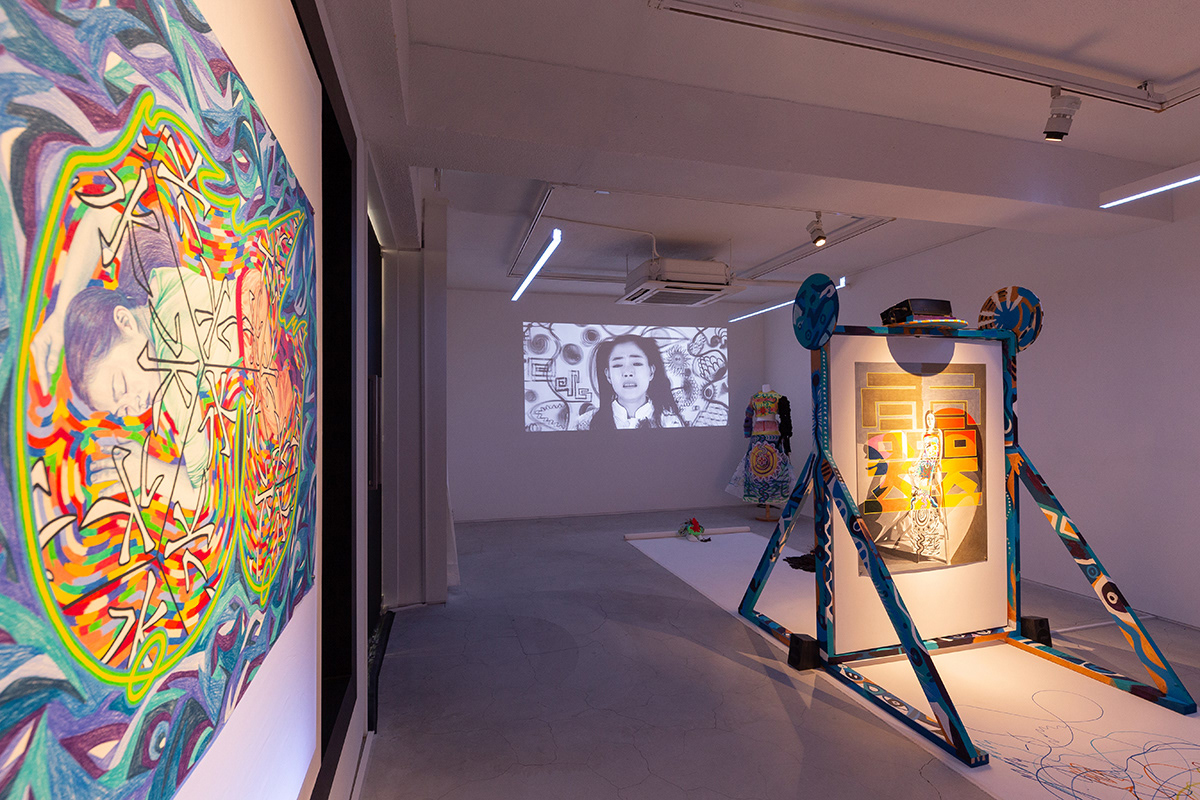
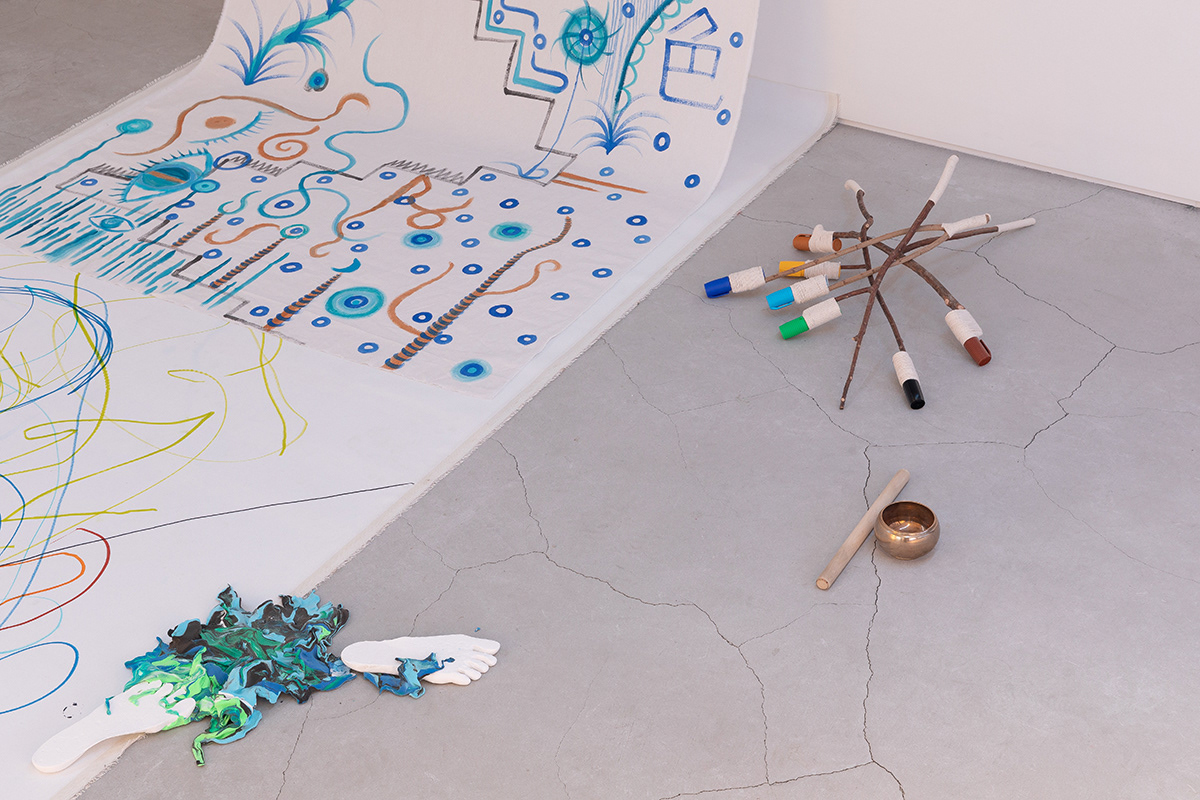

COLLABORATIVE PAINTING : COSTUME : Strands, holes, dark blue I & II, 2021, acrylic on canvas, yarn, hanbok fabric, art by Ahra Jo x Yujin Lee, costume design by ondal
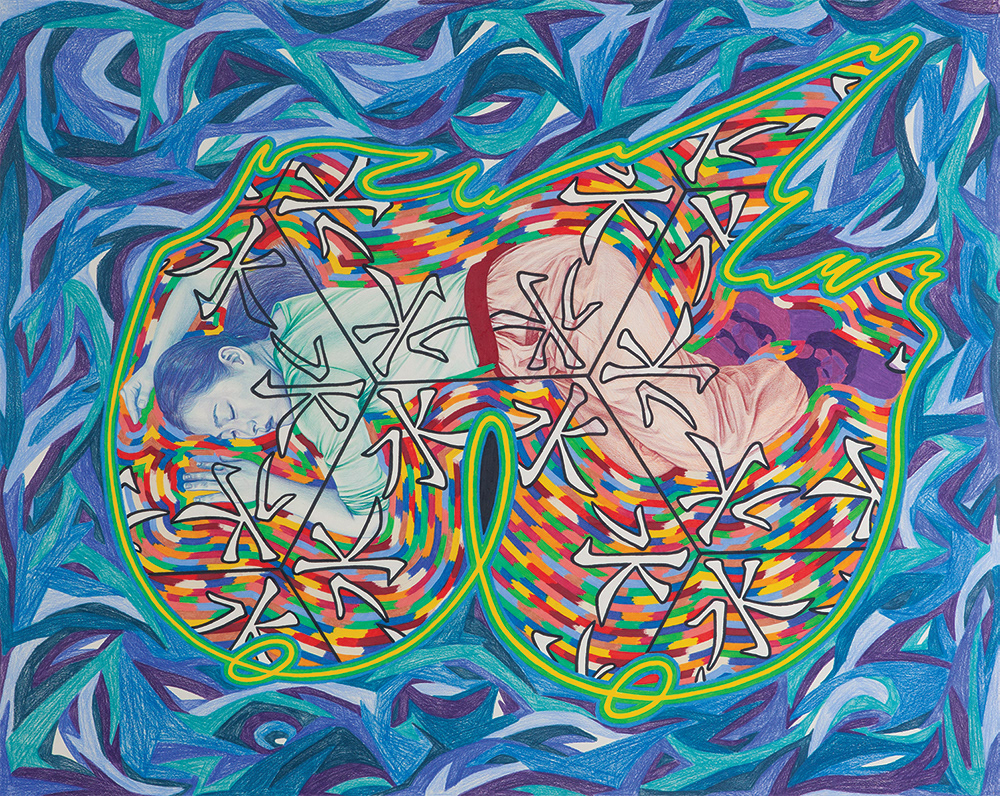
Yujin Lee, IMAGE 1 : THE SHIP ON THE SEA, 2021, color pencil on paper, 114x91.5cm

Yujin Lee, IMAGE 2 : JO AHRA, 2021, color pencil on paper, 91.5x114cm
Collective Statement
In “Be-Muse: Wind and Unwind,” visual artist Yujin Lee and performance artist Ahra Jo become each other's muse. Like an amusement or conversation, Lee and Jo’s co-creation takes place during their sporadic cohabitation, which lasts from a few consecutive days to a full month. In the process, divergent layers and connections are added through their engagement with many artists from different disciplines. Embracing countless metamorphosis, their relational art manifests into a living and breathing artistic language. From the perspective of the performing arts, the visual arts, and everything in between, their engagement with the process is ceaseless, especially in their commitment to critically, performatively, and organically dismantle and reassemble (wind and unwind) both their relationship and collaboration. “Be-Muse: Wind and Unwind” is a relational project that believes in the virtuous cycle of everyday life and the practice of art.
Yujin Lee is a visual artist who experiments with process art and relational art using a variety of media and methods like drawing, video, performance, audience-participatory projects, and collaborations. Lee believes art to be a ‘way of practicing life,’ creating a singular yet variable experience, its recollections and documentations, and other incidental art objects that are like amulets, neither to be easily discarded nor cherished.
Ahra Jo is an active director, choreographer, writer, singer, dancer, and actress. She runs a project group named, BodySoundSpeakJoAhRa, that explores various stories and forms using body, sound, and speech. The group focuses on creating process-oriented works that echo the sentiment of the audience, heighten the senses of the body, and connect sound with movement.
이유진 x 조아라 작업 노트
시각예술가 이유진과 공연예술가 조아라는 <Be-Muse : 맺고 풀고>를 통해 서로의 뮤즈가 된다. 함께 생활하면서 놀이처럼 혹은 대화처럼 공동 창작을 실천한다. 변태變態를 거듭하는 이들의 관계성은 여러 분야의 예술가와 만나 진화하며 다양한 면모와 맥락이 중첩되는 예술적 언어로 발현된다. 이 변태의 과정은 공연예술의 관점에서, 시각예술의 관점에서, 퍼포먼스의 관점에서 비평적으로, 수행적으로, 유기적으로 해체와 재조립을 반복하며, 뭉쳤다 흩어지고, 흩어졌다 다시 뭉쳐진다. <Be-Muse : 맺고 풀고>는 삶 속에서 예술을 실천하고 예술 속에서 삶을 발견하는 관계 예술의 선순환적 구도求道이다.
이유진은 드로잉, 영상, 퍼포먼스, 관객 참여형 프로젝트 및 협업 등 다양한 매체와 방식으로 과정미술과 관계예술을 실험하는 시각예술가다. 그에게 창작은 곧 ‘실천하는 것’으로 그것의 결과물은 다변적이면서 유일무이한 경험, 그것의 기억 및 기록, 그리고 쉽게 버리지도 각별히 보존할 필요도 없는 누군가의 필요성에 의해 만들어진 부적 같은 미미한 미적 오브제들이다.
조아라는 ‘몸소리말조아라’의 대표이자 연출, 안무가, 작가, 소리꾼, 무용수, 배우 등으로 활동하고 있다. ‘몸소리말조아라’는 몸, 소리, 말을 바탕으로 다양한 이야기와 형식을 탐구하는 프로젝트 그룹으로 삶과 예술의 선순환 구조 속에서 과정 중심적인 작품을 만들어 관객들과 공명하고, 지금 여기, 몸을 감각하고 소리와 움직임을 연결하는 작업에 집중하고 있다.

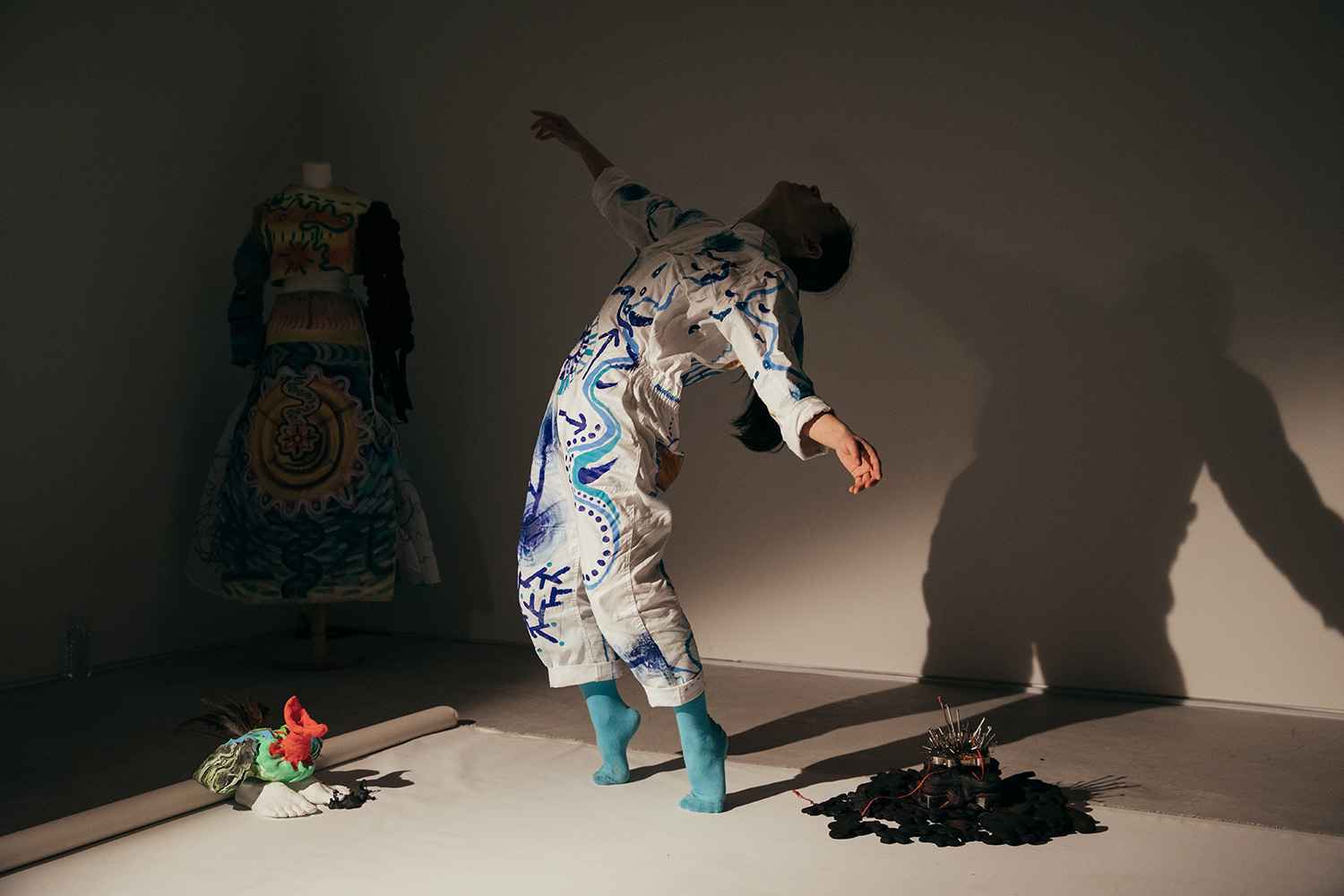

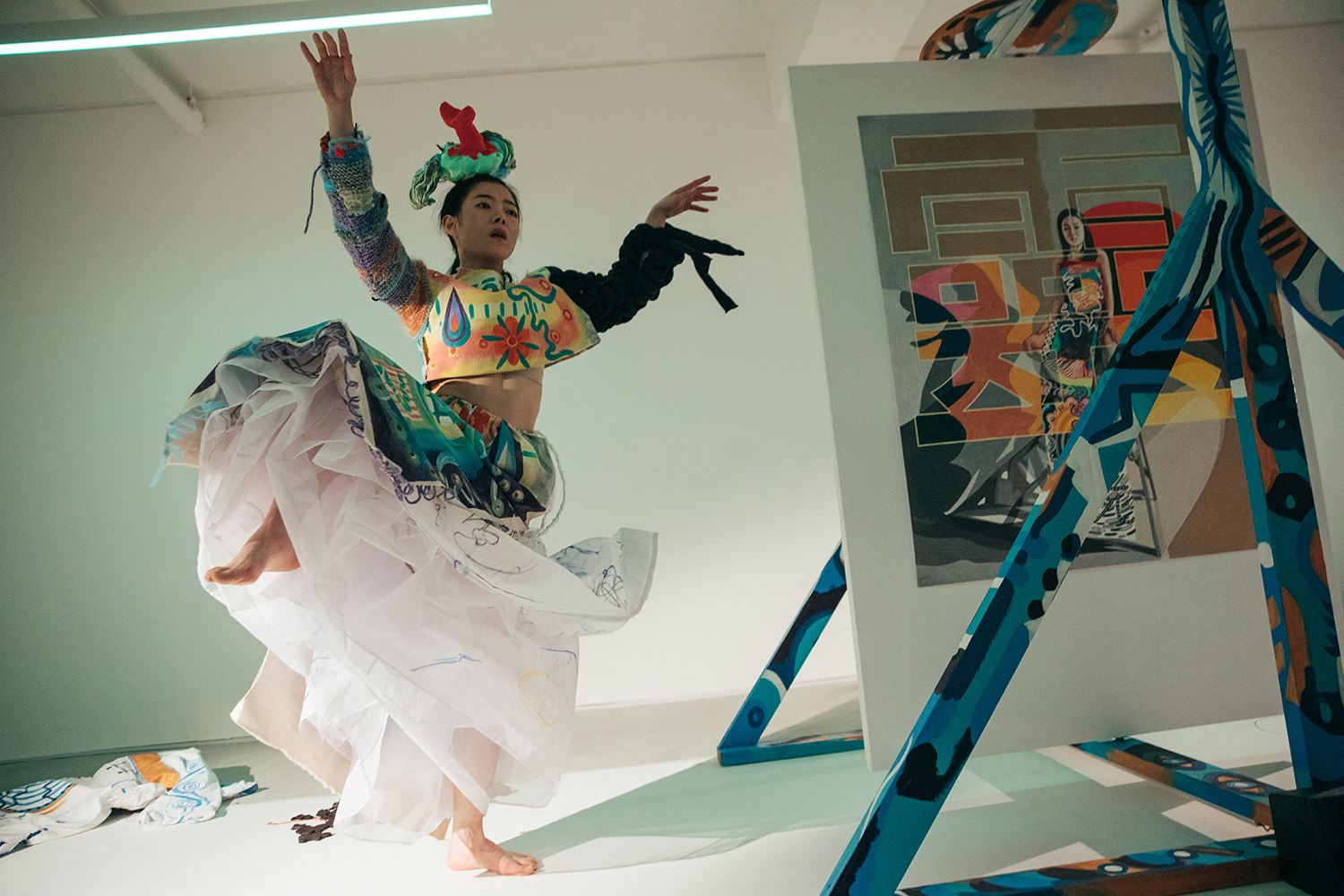


Ahra Jo, PERFORMANCE : BODY THAT METAMORPHOSIZES, 2021
Improvisational performance, marker on canvas, 108min
Performers: Ahra Jo x Yujin Lee, Lighting: Jung Yooseok
조아라, <퍼포먼스 : 변태하는 몸>, 2021
즉흥 퍼포먼스, 캔버스에 마커, 각 세션: 108분
퍼포머: 조아라x이유진, 조명: 정유석

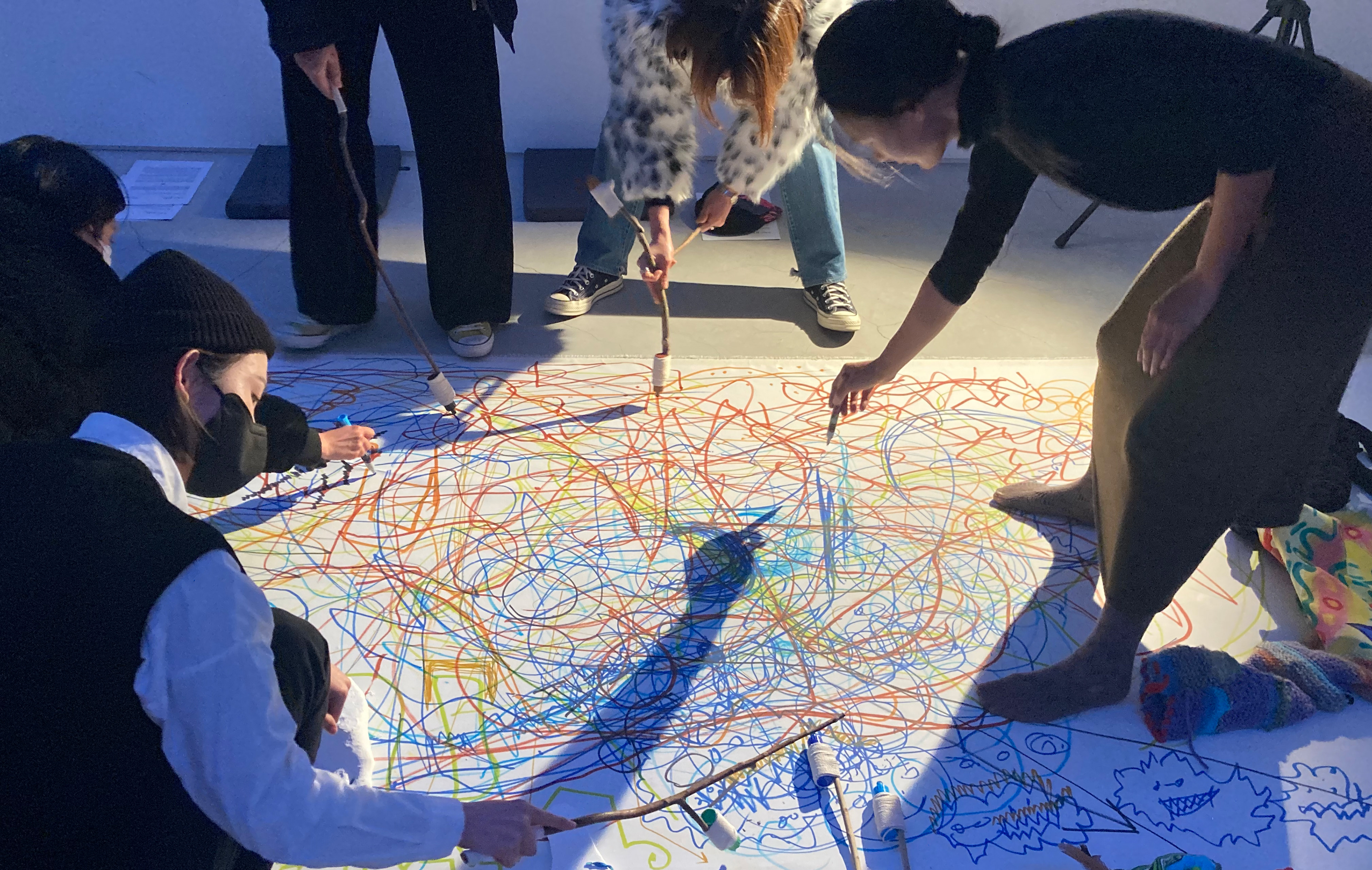
Collaborative drawing (detail) created from PERFORMANCE : BODY THAT METAMORPHOSIZES, marker on canvas
<퍼포먼스 : 변태하는 몸> 中 관객 참여로 완성된 협동 드로잉 (디테일), 캔버스에 마커, 135x900cm
Exhibition text by Hyesu Cho
Muse : : Muse
Be-Muse : Wind and Unwind is better off without this text. In Against Interpretation, Susan Sontag describes interpretation as a conscious act, a kind of justification that began from the scientific approach of the Enlightenment. The kind of interpretation that Sontag opposes are the ones that establish a set of principles or construct a code to be deciphered. It is a perpetual cycle of translation that describes how X is in fact A, that Y is in fact B, and that Z is in fact C.
All the same, bear in mind that such translation work is yet again conducted in a language that has already gone through another translation. We chiefly live under a symbolic system of patriarchal language, in a world of interpretation that is imprisoned by such language.
Many contemporary female artists’ practices have been propelled toward the language before patriarchy, while facing the dilemma of having to translate her life with the language of the patriarchal world. As Freud took both texts and individual lives as cases for his interpretation, women, especially anonymous muses, have been disassembled, described, interpreted, and translated, as if they are some text, waiting to be justified.
Then, what justification should I inflict upon the two female artists who have decided to become each other's muse?
Here are two artists: an artist whose self-realization process was impounded by a global pandemic (Ahra Jo), and an artist who’s daily life embraces the irony of the symbiotic life where death is ordained (Yujin Lee). To practice being each other's muse, they chose silent forms (yoga, drawing, cooking, etc.) instead of elaborate language describing their relationship.
As revealed in their artist notes, all of their activities point back to the Buddhist concept of Sunyata (nothingness). “Nothingness is not nothing. Everything exists in a relationship.” (2021.3.14. Notes from Jo’s Essay Album) The core concept of Sunyata is that truth cannot be verbalized, and that all things exist interdependently. Their collaboration formed upon a foundation of other relationships that have emerged out of their oscillation. Their lovers, yoga teacher, animals and other worldly beings are not mere subdivisions of their relationship, but equal and distinct collaborators co-creating an extended web-like entity. At the same time, these elements also act as a kind of interpretive device that evokes life’s dilemmas for the artists.
Lee and Jo form their own interpretations by “be-museing” each other. And rather than translating this into language, they take on a non-verbal interpretation of collaborative art making--the process of reverting back to the everyday. In silence, a new form, *, surfaces between the two. It is a trace, a result of an action, Pratitya-samutpada, the “interdependent co-arising” or Nidana, “links.” (From Lee's studio note) The outcome may or may not be a physical work of art, as not all creative practices necessarily hold materiality. This guides us to recognize how the essence of art mirrors the concept of Sunyata.
Previously, the relationship between the artist and his muse was that of one-sidedness and exclusivity, which no one dared to intervene. However, here, situated between the gazes of these two muses is . Like the exhibition’s subtitle, Wind and Unwind, Lee and Jo’s new clothes are sewn with their exchanging breaths. With it, they are transformed into completely different individuals, while being the same person that they have always been.
Here is a chair of silence, willfully left unoccupied. I dread taking that seat and making a cacophony of interpretations (among other things). That would be reinstating the violence of language, and replacing “nothingness” with “nothing.” It feels like a betrayal. (Though this betrayal is inevitable. As we live in a world of language, where we are left to inadequately utter how we live in a world of language. And above all, I have agreed to participate in their collaboration as a “critic.” The documentation of our meetings leading up to this writing have captured my very best act of wiggling through it all.) When two female artists place 'be-' in front of themselves (as each other’s muses), where should the critic, who had always contemplated the relationship between the artist and her muse from afar, stand? As did the previous Nidanas, I invite the audience to join me by taking a temporary seat between Ahra Jo and Yujin Lee or dancing around the fringes of the . To some extent, this text is also my own contemplation of what it means to “be” a critic. If interpretation is a matter of + -, I want to take it with me at zero, leaving no traces behind.
*I used to mark the form of Lee and Jo’s collaboration because what they create sometimes lacks a concrete form. But more so, an image of a black rectangle seemed closer to the indescribable concept of Sunyata than such depleted words like a “thing” or “something.”

page 10

page 12
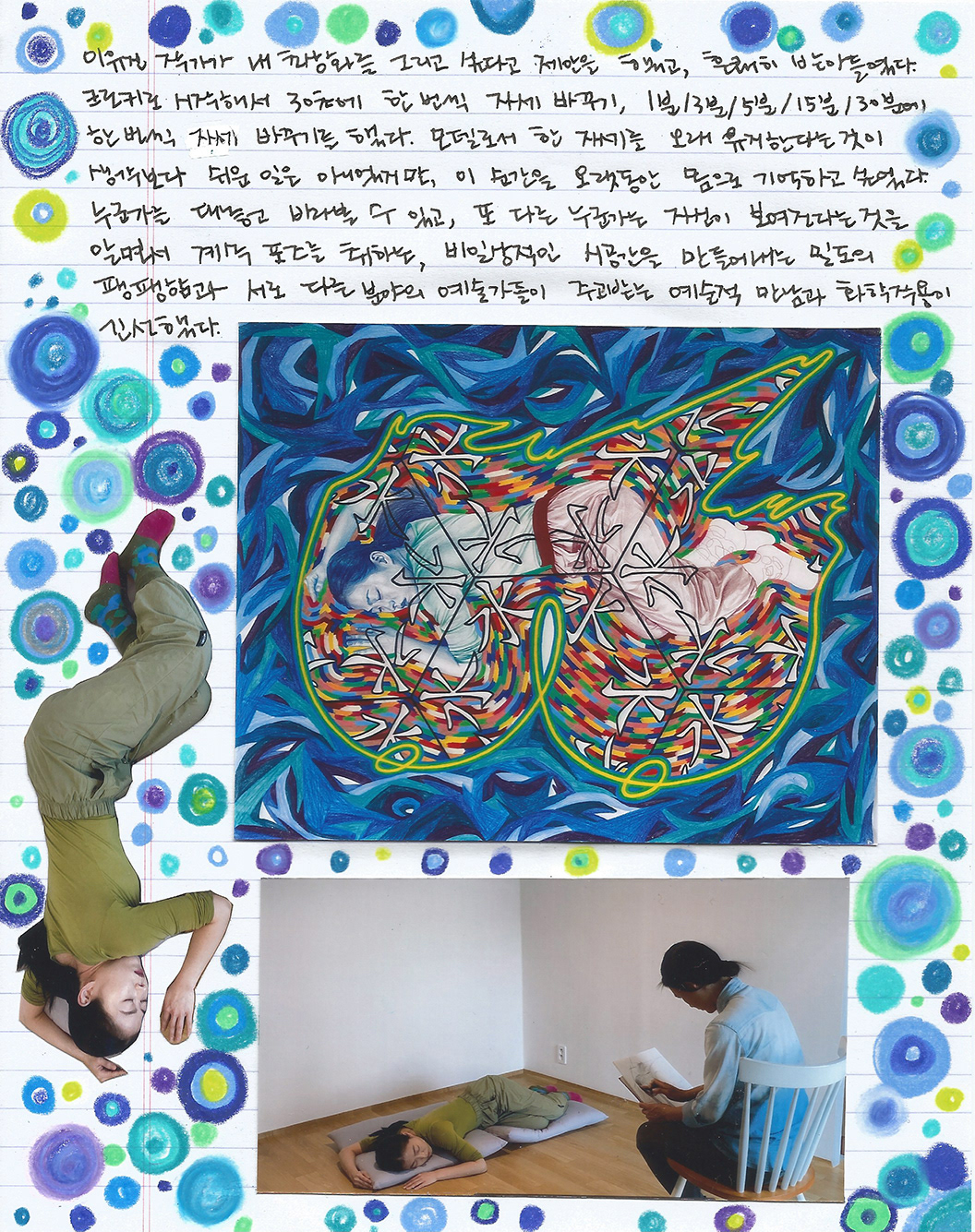
page 22

page 23

page 32

page 39

page 44

page 45

page 47
Ahra Jo, BE-MUSE : ESSAY ALBUM, 2021
Collaborative drawing printed on fabric, photo album, mixed media, collage,
32x31x6cm
조아라, <Be-Muse : 에세이 앨범>, 2021
협동 드로잉이 디지털 인쇄된 천, 포토 앨범, 혼합 매체, 콜라주, 32x31x6cm
STRUCTURE FOR VISUAL ART AND PERFORMANCE : THE SHIP ON THE SEA, 2021
Acrylic on wood, dimension variable
Design: Ahra Jo x Yujin Lee, Production: Yang Kura
<회화와 퍼포먼스를 위한 구조물 : 범피중류>, 2021
목재에 아크릴, 가변크기
디자인: 조아라x이유진, 제작: 양쿠라
글. 조혜수
Muse : : Muse
<Be-Muse : 맺고 풀고>는 비평이 없는 편이 가장 ‘올바르게’ 설명 될 수 있다. 수전 손택은 <해석에 반대한다> 에서, 해석이 과학적 계몽주의로부터 시작된 일종의 정당화, 의식적 행위임을 서술한 바 있다. 수전 손택이 반대하는 해석이란 일련의 법칙을 예증하거나 암호를 만드는 것. X가 사실은 A를 나타낸다는 것을, Y가 사실은 B라는 것을, Z가 실은 C라는 것을 계속해서 번역해 내는 일이다.
그러나 그러한 번역 작업도 사실은 또 한 번 번역을 거친 언어로 이루어지고 있다는 것을 유념할 필요가 있다. 우리는 특히나 아버지와 아들의 관계에 의해 설정되어 온 언어적 상징 체계, 이 고정된 언어 속 해석의 세계에 살고 있다.
현대의 많은 여성 미술가들은 부권(父権)적 언설이 지배되기 이전의 언어를 향하여 작품을 생산해왔다. 동시에 자신의 삶에 대해서, 주어진 이 세계의 언어로 번역 해야하는 딜레마를 마주쳐왔다. 프로이트에게 텍스트 뿐만 아니라 개인의 사건들도 모두 해석을 위한 사례였던 것처럼, 여성은 특히 익명의 뮤즈, 즉 정당화에 안달 난 텍스트로서 취급되어 낱낱히 분해되고 해설 되고 설명 되고 번역 되어 왔다.
그렇다면, 서로의 뮤즈가 되기로 결정한 두 여성 아티스트에 대해 또 내가 어떤 정당화를 가해야 할까?
여기, 그나마 주어졌던 자기 증명의 과정조차 전 지구적 질병의 상황으로부터 압수 당한 예술가(조아라)와 죽음이 예정된 공생 위에서 일상을 받아들이는 예술가(이유진)가 있다. 그들은 서로의 뮤즈가 되기로 결정 하면서, 복잡한 언어로 그들의 관계를 설명하기보다 어떠한 ‘말 없음’(요가, 침묵 드로잉, 요리 등)을 선택한다.
그들의 작업노트 등에서 드러나듯, 이들이 함께 하는 모든 행위는 불교의 공(空) 개념으로 이어진다. “공(空)은 무(無)가 아니다. 모든 것은 관계 속에 있다.” (2021.3.14. 조아라 에세이) 공 개념의 핵심은 결국 진리는 언어화 할 수 없다는 것, 동시에 만물은 연결성을 통해 존재하게 된다는 것에 있다. 두 사람의 순환 속에서 확장된 또다른 관계들은 그들의 작품이 존재할 수 있도록 하는 근본이 된다. 그들의 애인, 요가 선생, 동물 등 이 세계를 이루는 구성 요소들은 부수적인 재료라기보다, 뮤즈와 동일 선상에 놓여진, 그물처럼 확장된 또 다른 존재들이다. 그리고 동시에 작가 개인에게 삶의 딜레마를 환기시키는 일종의 해석적 장치로서 발견된다.
두 사람은 각자 서로를 뮤즈화 함으로써 스스로 해석을 생산한다. 그리고 그를 언어로 번역 하기 보다 합동 창작이라는 비언어적 해석 ー 다시 일상을 만드는 회귀 과정 ー 으로 되돌리고 있다. 침묵과 함께, 그들의 중간 지점에서 나타나는 새로운 형태 무언가 * 는, 연기(緣起) 즉 모든 존재의 동시적 상호 의존성으로서의 흔적이자 결과물이다. (“인연因緣-연기緣起” 이유진 작업노트) 이 흔적들은 물리적인 작품이 되기도 하고 그렇지 않을 때도 있다. 예술적 행위가 반드시 물질성을 포함하는 것은 아니다. 이는 예술의 특성 역시 공 개념과 닮아있음을 깨닫게 한다.
기존의 창작자와 뮤즈 간의 관계는 일방적이면서도 타인이 끼어들 수 없는 독점적 관계였다. 그러나 여기 두 뮤즈의 마주봄 사이에는 가 끼어있다. ‘맺고-풀고’라는 부제처럼 공기(空氣)를 바느질 해 옷을 기워 입듯, 그들은 전과 전혀 달라지지 않은 모습으로 전혀 다른 개인이 된다.
나는 일부러 비워둔 이 침묵의 의자에 (많고 많은 것들 중에서도) 부디 비평을 끝끝내 끌어 앉혀 시끄럽게 떠드는 일 따위는 되도록 하고 싶지 않다. 그것은 폭력적 언어로의 귀환이며, 공을 ‘무’로 치환하는 일이기 때문에 그들을 배신하는 일처럼 보인다. (하지만 배신은 불가피하다. 왜냐면 우리는 이미 언어의 세계에 살고 있으며 언어의 세계에 살고 있다는 사실을 한계적 언어로 말해야 하며 심지어 나는 이 전시의 비평가로 참여해 버렸기 때문이다. 이 전시의 참여 기록에는 그 말도 안 되는 발버둥의 최선 역시 남아있다.) 두 여성 작가가 자기(뮤즈) 앞에 ‘Be-’를 붙인다면, 창작자와 뮤즈를 관조하며 떠들던 비평가의 위치는 어떻게 변화 해야 하는가? 다른 인연의 조각들이 그러했듯이, 조아라와 이유진 사이, 에 잠깐 앉거나 주변부를 빙글빙글 도는 방식으로 나와 관객들이 함께 하길 바란다. 그 때문에 이 비평은 비평가-되기 에 대해서 고민하는 나 자신의 이야기이기도 하다. 해석이 + - 의 문제라면, 흔적 없이 해석을 데려 가고 싶다.
*내가 그들의 작품 형태를 로 표기하는 까닭은, 그들이 만들어내는 것이 구체적인 형태를 갖지 않는 경우도 존재하거니와, ‘무언가’ 혹은 ‘어떤 것’ 등으로 언어화 하는 것보다 비어 있는 시각적 이미지가 그들이 드러내고자 한 ‘공’의 성질과 가깝다고 생각했기 때문이다.